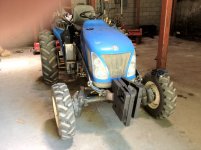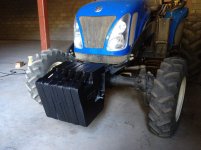Norcal M5
Bronze Member
- Joined
- Apr 26, 2011
- Messages
- 80
Hi All,
I'll take delivery of an 80 gallon sprayer this week and to use it most effectively, I'll be removing my FEL to more easily turn around at the end of my vineyard rows. The sprayer plus 50 gallons (that's all I dare carry around my steep vineyard) comes to about 800 pounds when full. My tractor (NH TC34DA) is 2600 pounds and has a 72" wheelbase. Thus the question - how much front end ballast will I need to keep the front end in optimum contact with the ground?
The easy answer, I suppose would be 800 pounds, but I suspect that's more than necessary as the fulcrum I'm concerned about would be the rear wheels when going uphill. The weight of the tractor in front of the rears would help hold it down, but I'm certain that I'll need more hanging off the front, as well as water in the front tires, especially as the grade increases.
BTW, I've used a 700 pound flail mower all over the hill with my FEL installed and never did the front feel light. If I knew how much an FEL weighs, it would be a good rough place to start.
Photo attached shows general slope.
I'll take delivery of an 80 gallon sprayer this week and to use it most effectively, I'll be removing my FEL to more easily turn around at the end of my vineyard rows. The sprayer plus 50 gallons (that's all I dare carry around my steep vineyard) comes to about 800 pounds when full. My tractor (NH TC34DA) is 2600 pounds and has a 72" wheelbase. Thus the question - how much front end ballast will I need to keep the front end in optimum contact with the ground?
The easy answer, I suppose would be 800 pounds, but I suspect that's more than necessary as the fulcrum I'm concerned about would be the rear wheels when going uphill. The weight of the tractor in front of the rears would help hold it down, but I'm certain that I'll need more hanging off the front, as well as water in the front tires, especially as the grade increases.
BTW, I've used a 700 pound flail mower all over the hill with my FEL installed and never did the front feel light. If I knew how much an FEL weighs, it would be a good rough place to start.
Photo attached shows general slope.



